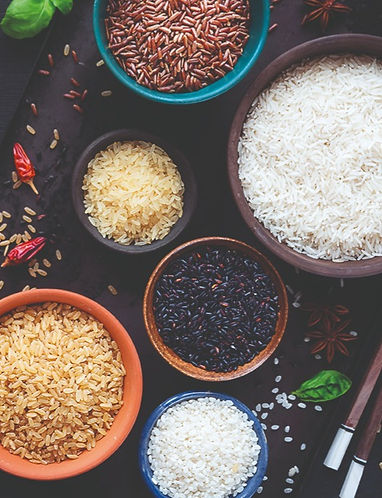
3. Rice & Rice Products
Rice, the food of the world!
Rice is the most eaten food product worldwide and as a cereal grain one of the main ingredients in Asian cuisine. Rice is the seed of the grass species ‘Oryza Sativa’. Rice cultivation is well-suited to countries and regions with low labor costs and high rainfall, as it is labor-intensive to cultivate and requires lots of water. Many different rice varieties are cultivated which have their very own distinctive characters and applications. People cultivate rice not only in Asia but all over the world. For example in Europe rice is cultivated in Spain and Italy.
WHITE RICE
White rice is grown worldwide. It is often referred to as polished or fully milled rice because the husk and bran are completely removed from the kernel. White rice is the staple consumed by the majority of the world’s population. Due to such extensive consumption the demand is high and it is harvested two or even three crops a year.

The king of rice is the Thai Hom Mali Rice. This number 1 Jasmine rice is also known as Thai fragrant rice, Thai scented rice or Pandan rice and is considered to be of the highest quality. This rice is harvested only once a year. It is processed until it becomes a perfect, long, slim, clear and glossy grain. Steamed well, the rice will be tenderly soft and chewy with an appetizing fragrant smell and flavour. This rice can be used for all kinds of Asian dishes.
The Thai Jasmine rice species are also cultivated in other countries besides Thailand, for instance Cambodia, Myanmar, and Laos. Our Royal Tiger Jasmine range for example comes from Cambodia.

JASMINE RICE
BROKEN RICE
Broken (Jasmine) rice is a ‘by-product’ of the rice production process. Some of the grains break during harvesting, transport and processing. It is fragrant and soft. Great to make porridge boiled rice or cereal-mixed rice. Some customers mix the cheaper broken rice with the more expensive Thai Jasmine Rice to save money and still experience a decent quality.

BASMATI RICE
Basmati rice is only grown at the foot of the Himalayas, and is an expensive, very aromatic, dry-cooking long-grain rice with lots of flavour. Basmati rice is used widely in Indian cuisine. It has a neutral flavour without any particular aroma, and a light texture.
Most Basmati rice originates from India and some rices from Pakistan. The Indian Basmati is considered to be of higher quality than the Pakistani Basmati rice.

SUSHI RICE
Sushi rice is used in both sweet and savory dishes; it has a white round, or medium grain, and after cooking it retains its shape and is very sticky. The rice itself is not sweet, but its composition gives the sticky rice a slightly sweet flavour.
Sushi rice is suitable to make sushi. The term sushi literally means "sour-tasting". When you prepare sushi the sushi rice is usually vinegared.


PARBOILED
This rice has been precooked and dried, which means that more nutrients are retained after the rice has been husked. This process also makes it easier to prepare the rice as the cooking time is shorter.
Golden Sella Basmati has the delicious taste and visual appeal of pure Basmati, but with improved holding ability and resilience to overcooking. The basmati is parboiled in its husk enabling it to cook and stir this rice without losing the texture.

HEALTHIER RICE VARIANTS
There are a few rice variants in our H&S assortment with are a healthier choice in rice. These rice species are not milled and the husk is still on the rice grain. Also organic rice is considered to be healthier compared to normal rice.
BROWN RICE
Brown rice is a whole-grain white rice with the inedible outer husk removed, it still contains the bran layer and the cereal germ. Brown rice and white rice have similar amounts of calories and carbohydrates but different nutritional content. Brown rice is a whole grain and a good source of magnesium, fibers etc.
Preparation: Brown rice takes longer to cook because of the bran layer and the cereal germ.

RED RICE
Red rice is a type of long grain rice which is unpolished. Therefore all the nutrients, vitamins and minerals are intact. Red rice has the highest nutritional value of rices. The flavour of cooked red rice is generally more sweet and nutty, and the texture is more chewy than standard white rice.
To create some attractive looking dishes red rice is often mixed with white rice.
Preparation: Soaking the rice in water for at least 30 minutes before cooking produces a softer texture. Red rice takes longer to cook than white rice, but not as long as brown rice.



RICEBERRY
Riceberry is a registered rice variety from Thailand. It is a deep purple whole grain rice with softness and a nice aftertaste.















